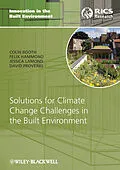The multi-disciplinary perspective provided here offers a strategic
view on built environment issues and improve understanding of how
built environment activities potentially induce global warming and
climate change. It also highlights solutions to these challenges.
Solutions to Climate change Challenges in the Built
Environment helps develop an appreciation of the diverse themes
of the climate change debate across the built environment
continuum. A wide perspective is provided through contributions
from physical, environmental, social, economic and political
scientists. This strategic view on built environment issues will be
useful to researchers as well as policy experts and construction
practitioners wanting a holistic view.
This book clarifies complex issues around climate change and
follows five main themes: climate change experiences; urban
landscape development; urban management issues; measurement of
impact; and the future. Chapters are written by eminent specialists
from both academic and professional backgrounds. The main context
for chapters is the developed world but the discussion is widened
to incorporate regional issues.
The book will be valuable to researchers and students in all the
built environment disciplines, as well as to practitioners involved
with the design, construction and maintenance of buildings, and
government organisations developing and implementing climate change
policy.
Autorentext
Colin Booth, Senior Lecturer, Construction and Infrastructure, School of Engineering and the Built Environment, University of Wolverhampton
Felix N. Hammond, Lecturer, Construction and Infrastructure, School of Engineering and the Built Environment, University of Wolverhampton
Jessica Lamond, Post Doctoral Research Fellow, Construction and Infrastructure, School of Engineering and the Built Environment, University of Wolverhampton
David G. Proverbs, Professor and Head of Department, Construction and Property, Faculty of Environment and Technology, University of the West of England
Klappentext
The multi-disciplinary perspective provided here offers a strategic view on built environment issues and improve understanding of how built environment activities potentially induce global warming and climate change. It also highlights solutions to these challenges.
Solutions to Climate change Challenges in the Built Environment helps develop an appreciation of the diverse themes of the climate change debate across the built environment continuum. A wide perspective is provided through contributions from physical, environmental, social, economic and political scientists. This strategic view on built environment issues will be useful to researchers as well as policy experts and construction practitioners wanting a holistic view.
This book clarifies complex issues around climate change and follows five main themes: climate change experiences; urban landscape development; urban management issues; measurement of impact; and the future. Chapters are written by eminent specialists from both academic and professional backgrounds. The main context for chapters is the developed world but the discussion is widened to incorporate regional issues.
The book will be valuable to researchers and students in all the built environment disciplines, as well as to practitioners involved with the design, construction and maintenance of buildings, and government organisations developing and implementing climate change policy.
Inhalt
Contributors xiii
Chapter 1 Introductory Insights to Climate Change Challenges 1
Felix N. Hammond, Colin A. Booth, Jessica E. Lamond and David G. Proverbs
1.1 Introduction 1
1.2 Climate Change Theory 2
1.3 The Controversy and Context 5
1.4 Organisation of the Book 8
Chapter 2 Climate Change: Nature and Emerging Trends 11
Mark McCarthy
2.1 Introduction to the Climate System and Changes to the Radiative Forcing 11
2.2 Emerging Trends (Global) 13
2.3 Emerging Trends (UK) 17
2.4 Climate Trends and the Built Environment 19
2.5 Solutions 20
Chapter 3 Regional Implications 23
Ana Lopez
3.1 Introduction 23
3.2 Climate Modelling 23
3.3 Projections of Future Climate Change 27
3.4 Solutions to the Challenges of Interpreting Climate Change Projections for the Characterisation of Climatic Risks 30
Chapter 4 Urbanization and Climate Change 33
Felix N. Hammond, Kwasi Baffour Awuah Gyau and Stanislaus Y. Adiaba
4.1 Introduction 33
4.2 State of the World's Urbanization 33
4.3 Impact of Urbanization on Climate Change 35
4.4 How Does Urbanization Affect Climate Change? 36
4.5 Solutions for Change 39
4.6 Conclusion 41
Chapter 5 Global Political Initiatives and Overtones 45
Jean-Luc Salagnac
5.1 Introduction 45
5.2 Climate and the Built Environment 45
5.3 Background to Political Initiatives 47
5.4 Mitigation and Adaptation Policies 50
5.5 Solutions to Climate Change Challenges for the Built Environment 53
Chapter 6 Green Economics Dialogue and the Built Environment 57
Miriam Kennet
6.1 Introduction 57
6.2 Examples of Unsustainable Building Practices 59
6.3 The Choices We Face 62
6.4 Green Projects in Action 68
6.5 Conclusions 72
Chapter 7 Strategic Environmental Impact Assessment 75
Joseph Somevi
7.1 Introduction 75
7.2 Strategic Environmental Assessment 76
7.3 Contributions of SEA to Climate Change Solutions 77
7.4 Concluding Remarks 84
Chapter 8 Methods for Valuing Preferences for Environmental and Natural Resources: An Overview 87
Jessica E. Lamond and Ian Bateman
8.1 Introduction 87
8.2 Monetary Evaluation of Environmental Preferences: Theory 89
8.3 Methods for Monetary Evaluation of Environmental Preferences 91
8.4 Solutions to Valuation of Environmental and Natural Resources 95
Chapter 9 Ecological Value of Urban Environments 99
Ian C. Trueman and Christopher H. Young
9.1 Introduction 99
9.2 Ecological Value 100
9.3 Urban Habitats 101
9.4 Landscape Scales and Urban Areas 106
9.5 Ecological Implications of Climate Change 107
9.6 Implications of Climate Change for Urban Ecology 108
9.7 Solutions to Climate Change Challenges for the Built Environment 108
Chapter 10 The Pedological Value of Urban Landscapes 113
Jim Webb, Michael A. Fullen and Winfried E.H. Blum
10.1 Introduction 113
10.2 Urban Soils: The 'Grey Areas' on Soil Maps 113
10.3 Policy Responses for Urban Soils 119
Chapter 11 Insights and Perceptions of Sustainable Design and Construction 127
David W. Beddoes and Colin A. Booth
11.1 Introduction 127
11.2 Sustainable Construction 128
11.3 Drivers for Sustainable Construction 130
11.4 Rethinking Construction 135
11.5 Thoughts for Change 137
11.6 Concluding Remarks 138
Chapter 12 Progress in Eco and Resilient Construction Materials Development 141
